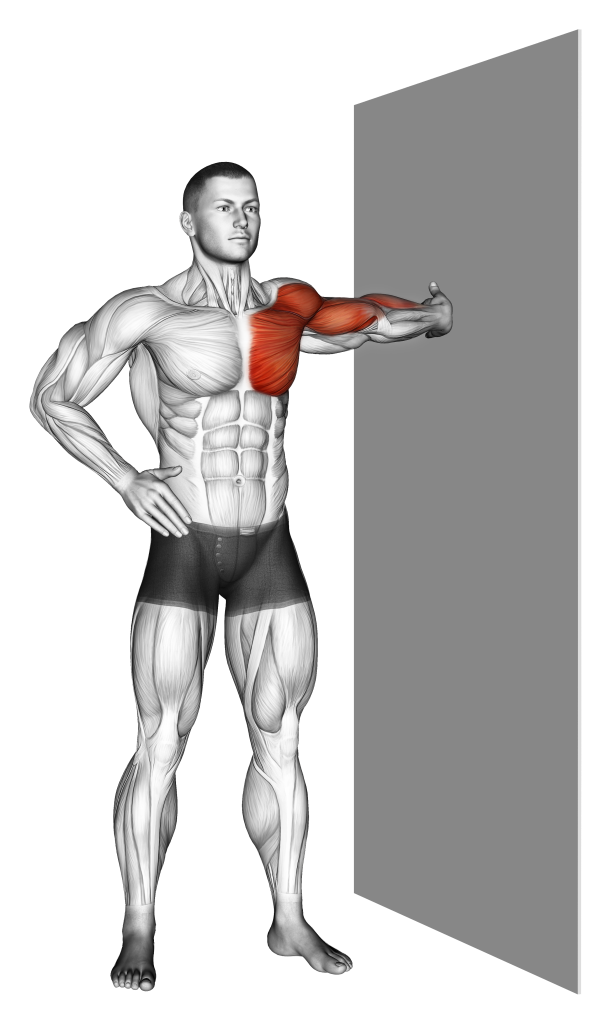3 de June de 2025
Chest Bicep Stretch: Exercise Guide, Tips and Benefits
Stretching the chest and biceps is often overlooked, yet it plays a crucial role in promoting upper body mobility, posture, and muscle recovery. The chest bicep stretch helps release tension from prolonged sitting, upper body training, or poor posture habits—making it ideal for athletes, lifters, and anyone working on shoulder mobility.
Whether you’re warming up, cooling down, or recovering from high-volume training or fatigue phases, this stretch supports functional range of motion and injury prevention.
What Is a Chest Bicep Stretch?
A chest bicep stretch is a mobility exercise that extends the arms behind the body to lengthen the pectoral muscles and the long head of the biceps. This stretch helps open up the front side of the torso, counterbalances pushing movements, and promotes better shoulder alignment. It’s commonly used in warm-ups, cooldowns, and mobility flows to reduce stiffness and promote a greater range of motion in the shoulders and arms.
How to Perform a Chest Bicep Stretch Correctly
- Stand tall with feet hip-width apart.
- Interlace your fingers behind your back and straighten your arms.
- Lift your hands upward slowly as you open your chest and pull your shoulder blades together.
- Hold the stretch for 20–30 seconds, breathing deeply and avoiding excessive back arching.
- To increase intensity, try leaning slightly forward while maintaining arm position or perform the stretch against a doorway for added resistance.
Tips:
- Keep your neck relaxed and shoulders down.
- Avoid letting the lower back overcompensate by engaging your core.
- Perform 2–3 rounds, especially after upper body training or long hours sitting.
Muscles Worked by the Chest Bicep Stretch
- Pectoralis major and minor (chest)
- Biceps brachii, especially the long head
- Anterior deltoids (front shoulders)
- Coracobrachialis, assisting with shoulder flexion and adduction
This combination of muscle groups plays a central role in posture, pushing strength, and arm movement control.

Benefits of the Chest Bicep Stretch
- Improved posture: Helps counteract rounded shoulders from sitting or training.
- Increased mobility: Frees up range of motion in the chest and arms.
- Injury prevention: Reduces the risk of strains from tight muscles during upper body work.
- Better performance: A more mobile chest and shoulder complex improves pressing and overhead movements.
- Recovery and relaxation: Eases post-workout tightness and aids recovery.
- Fatigue management: A helpful tool during deloads or high fatigue periods where mobility takes priority over load.
This stretch supports better alignment and can reduce strain in the shoulders, arms, and upper back, helping prevent postural imbalances common in strength training.
Common Mistakes to Avoid
- Overarching the lower back: Focus on spinal neutrality.
- Forcing the stretch: Go only to the point of mild discomfort.
- Shrugging the shoulders: Keep them relaxed to target the chest and biceps properly.
- Holding your breath: Controlled breathing enhances the effectiveness of the stretch.
Stretching without activating the surrounding muscles can lead to instability and less effective results—especially during high-volume training or fatigue phases.
Variations of the Chest Bicep Stretch
- Wall Chest Stretch: Place your palm on a wall at shoulder height and turn your torso away.
- Doorway Stretch: Place hands on the sides of a doorway, step through gently to stretch the front body.
- Supine Arm Opener: Lie face-up with arms extended out at shoulder level, palms facing up.
- Resistance Band Stretch: Use a light band behind your back to add gentle tension.
These variations offer scalable options depending on your flexibility and goals.

How to Incorporate Chest Bicep Stretch in Your Routine
You can use this stretch as part of a warm-up or cooldown, ideally after upper body sessions or periods of inactivity. Hold for 20–30 seconds per side, repeat for 2–3 rounds, and combine with other thoracic or shoulder mobility drills. Integrating this stretch into your routine can enhance mobility, reduce tightness, and improve posture—especially when included as part of a smart strength and conditioning program.
FAQs About the Chest Bicep Stretch
What is a chest bicep stretch?
It’s a mobility movement that targets the front of your shoulders, chest, and biceps to improve flexibility and counteract tightness.
How do you stretch the bicep?
Extend the arm behind you with the palm facing forward (thumb down or up), then gently rotate the torso or elevate the hand to increase the stretch.
Why am I feeling chest workouts in my biceps?
Likely due to the involvement of the biceps in pushing or stabilization, especially if your technique causes compensation or you lack shoulder mobility.
Can I do chest and biceps together?
Yes. Training them in the same session is common and efficient, especially since they don’t heavily interfere with each other and can even aid supersets.
How do you loosen tight pecs?
Use stretches like the chest bicep stretch, foam rolling, doorway stretches, and mobility drills focused on thoracic extension and shoulder external rotation.
If you’re looking to improve posture, reduce upper body tightness, and support performance, the chest bicep stretch is a simple yet powerful tool. Make it a regular part of your mobility routine to recover better, move more freely, and reduce the risk of injury—especially during fatigue-heavy training blocks or in the context of a well-rounded strength and conditioning strategy.
